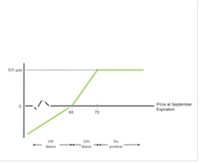Certain trades gone wrong may be candidates for this straightforward call option strategy, which can be used to quickly recoup losses without incurring additional downside risk.
It’s been a rough ride for a lot of investors. Some are waiting (patiently) for some of their losers to turn around. Some traders are buying at new, cheaper prices. But as experienced investors know, the market can always go lower, sometimes fast and furiously. There is one more alternative that can make sense in some cases: the “stock repair” strategy.
Introduction to the Stock Repair Strategy
The stock repair strategy is a strategy involving only calls that can be implemented when an investor thinks a stock will retrace part of a recent drop in share price within a short period of time (usually two to three months).
The stock repair strategy works best after a decline of 20%-25% of the value of an asset. The goal is to “double up” on potential upside gains with little or no cost if the security retraces about half of its loss by the option’s expiration.
3 Benefits of This Strategy
There are three benefits the stock repair strategy trader hopes to gain. First, little or no additional downside risk is acquired. This is not to say the trader can’t lose money, however. The original shares are still held, so if the stock continues lower, the trader will increase their losses. This strategy is only practical when traders feel the stock has “bottomed out.”
Second, the projected retracement is around 50% of the decline in stock price. A small gain may be marginally helpful. A large increase will help, but will have limited effect.
Third, the investor is willing to forego further upside appreciation over and above original investment. The goal here is to get back to even and be done with the trade.
Implementing the Stock Repair Strategy
Once a stock in an investor’s portfolio has lost 20%-25% percent of the original purchase price, and the trader is anticipating a 50% retracement, the investor will buy one close-to-the-money call and sell two out-of-the-money calls whose strike price corresponds to the projected price point of the retracement.
Both option series are in the same expiration month, which corresponds to the projected time horizon of the expected rally. The “one-by-two” call spread is ideally established “cash-neutral,” meaning no debit or credit. (This is not always possible—more on this later). To better understand this strategy, let’s look at an example.
Article Continues on Page 2
|pagebreak|Example
An investor buys 100 shares of XYZ stock at $80 a share. After a month of falling prices, XYZ trades down to $60 a share. The investor believes the stock will rebound, but not all the way back to his original purchase price of $80. He thinks there is a reasonable chance for the stock to retrace half of its loss (to about $70 a share) over the next two months.
The trader wants to make back his entire loss of $20. Furthermore, he wants to do it without increasing his downside risk by any more than the risk he already has (with the 100 shares already owned). The trader looks at the options with an expiration corresponding to his two-month outlook, in this case, the September options.
The trader buys one September 60 call at 6 and sells two September 70 calls at 3. The spread is established cash-neutral.
Bought: 1 September 60 call at 6Sold: 2 September 70 call at 3 (x2)
By combining these options with the 100 shares already owned, the trader creates a new position that gives double exposure between $60 and $70 to capture gains faster if his forecast is right. Figure 1 shows how the position functions if held until expiration.
See the graphical representation of this below (I apologize for the small size):
If the stock rises to $70 a share, the trader makes $20, which happens to be what he lost when the stock fell from $80 to $60.
The trader would be able to regain the entire loss in a retracement of just half of the decline. With the stock above $60 at expiration, the 60-strike call could be exercised to become a long-stock position of 100 shares. That means the trader would be long 200 shares when the stock is between $60 and $70 at expiration.
Above $70, however, the two short 70-strike calls would be assigned, resulting in the 200 shares owned being sold at $70. Therefore, further upside gains are forfeited above and beyond $20.
But what if the trader is wrong? Instead of rising, say the stock continues lower and is trading below $60 a share at expiration. In this event, all the options in the spread expire and the trader is left with the original 100 shares. The further the stock declines, the more the trader can lose. But the option trade won’t contribute to additional losses. Only the original shares are at risk.
Benefits and Limitations of the Stock Repair Strategy
The stock repair strategy is an option strategy that is very specific in what it can (and can’t) accomplish. The investor considering this option strategy must be expecting a partial retracement and be willing to endure more losses if the underlying security continues to decline. Furthermore, the investor must accept limiting profit potential above the short strike if the stock moves higher than expected.
Some stocks that have experienced recent declines may be excellent candidates for stock repair. For others, the stock repair strategy might not be appropriate.
For stocks that look like they are finished or may even head lower, the stock repair strategy can’t help—just take your lumps! But for those that might slowly climb back just partially, this can be a powerful option strategy to recoup losses fast.
By Dan Passarelli of MarketTaker.com





















